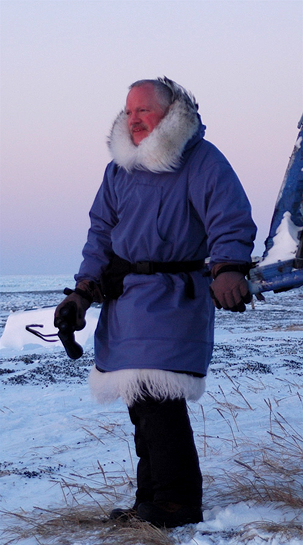The evening wind was a howling whistle as it curled around the small 14 x 16 foot plywood building that was the workshop. I was a new arrival in the small village of Gambell, on the eastern tip of St. Lawrence Island, nestled on a gravel filled stretch of land that juts out into the remote and rough Bering Sea. It is near the edge of tomorrow, I thought, being close to the International Date Line and the mountains of Russia loom on the horizon. The roar of the wave-obsessed sea could be heard in the distance, plus an occasional four-wheeler with kids spurting past.
I had come to visit with Merle Apassingok. He is a bright-eyed strong looking, middle-aged man with a thin mustache who works as a grant writer for the village. But he is also a successful ivory and bone carver. But instead of the word “carver”, he would prefer the Siberian Yupik word, “Ulima”, which means, “to make or create something”.
“I sold my first piece for $12.00 when I was eight years old,” he said with a smile. “But it wasn’t until later in life I realized it was a gift that I should be utilizing. I saw it as a powerful way to help my family and people in the community.”
I learned that his carvings sold for anywhere from around $100.00 to over a thousand. He mentioned that a couple of buyers fly into the village monthly to purchase local carvings and artifacts. Once in Anchorage the price of each piece at least doubles.
He stopped grinding and shaping a polar bear with a cub, the length of an adults’ hand and made from walrus ivory. He stopped and looked deeply into the piece, studying it closely, to see what reality it might possess.
Merle sat directly under a single light bulb that dangled down from the ceiling, just above his lap. The shop was clean and tidy with a small collection of whale and walrus bones in one corner and a number of small electric grinders and polishers hanging on a board next to his chair. A large walrus tusk stood about three feet tall in the shadows of the back wall. The dusty, pearly white curved tusks seemed to speak of an ancient earthly time that lies on the edge of our lives, much like the windy sea does.
With some apprehension I decided to risk saying the question that had been twisting its way through my mind, “How do you see your carving?”
The downcast look in his dark eyes told me that he did not understand my question, so I tried again, “What does it mean to you?”
With a direct, serious look he said, “For me it is not just a carving but a learning experience,” he said.
He grabbed his electric polisher tightly and sat up straight as though to stretch out some sore back muscles. “You see, carving to me is a secondary benefit from hunting,” he said. “I see the walrus, the whale and polar bear and I remember them well. That’s what I use in my carvings.” He stopped abruptly as though searching for thoughts and then continued, “My vision is influenced by hunting.”
Sitting there next to him I felt so close but still far away in my search to understand his vision. Merle was saying the right words but I lacked understanding. I felt lost and the sound of the ocean surf once again curled through my mind and the wind howled like lost souls passing over the small shadow filled building. In my quest to connect with another culture I seemed to have lost my way.
Then I had an idea from college. “Michelangelo carved individuals struggling to free themselves from blocks of granite. What do you see coming out of your ivory and whale bones?”
Again the winds shook the walls and wailed mournfully and I imagined the ocean waves like cat claws scratching relentlessly at the cold gravel beaches of Gambell.
Merle fell silent and slumped a little. I felt he understood the question this time, but it was a thought he had never contemplated before.
He got up and walked to the back of the workshop. When he returned he had a small picture of himself as a young man with a rifle wearing thickly insulated winter hunting clothing. Though many years old the picture was still in good shape. Then he said confidently, “Years ago I made some carvings of a hunter like myself.” He pointed toward the stomach of his body in the picture, “I hollowed out the middle so you could see through it and I put the head of a walrus or polar bear or a whale in it.”
Slowly understanding dawned on me. He was defined by hunting like much of Eskimo Art as well, I thought. They had a deep love for the spirit that comes from Nature. Just like the whale, walrus and polar bear, he did not just observe and analyze nature but worked to become a deep part of it, like a hunter with a polar bear inside of him. They find a sense of freedom by being so involved with nature. I do much the same while on vacation camping.
I enjoyed the brief talk with Merle that evening; it helped me to better understand native art, I decided while walking back home.
Seeing the skull of a bowhead whale lying in the tall grass near my house I wondered if its spirit sees the windy sea in its dreams the same way Merle sees the polar bear and cub in his ivory. Perhaps the job of art is to show us the way back to nature’s reality. A reality so easily lost in our people busy world.

